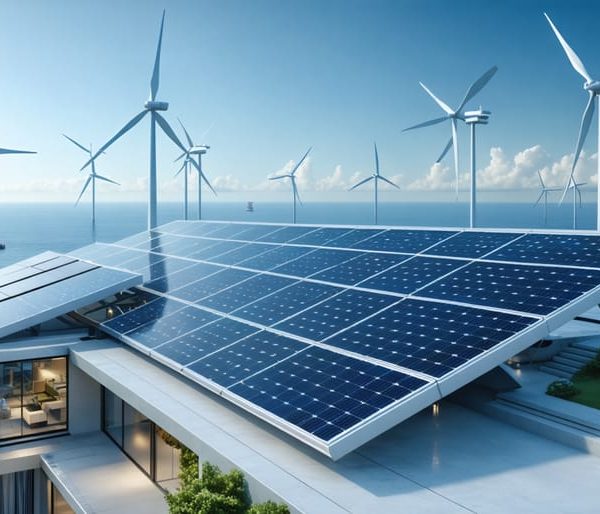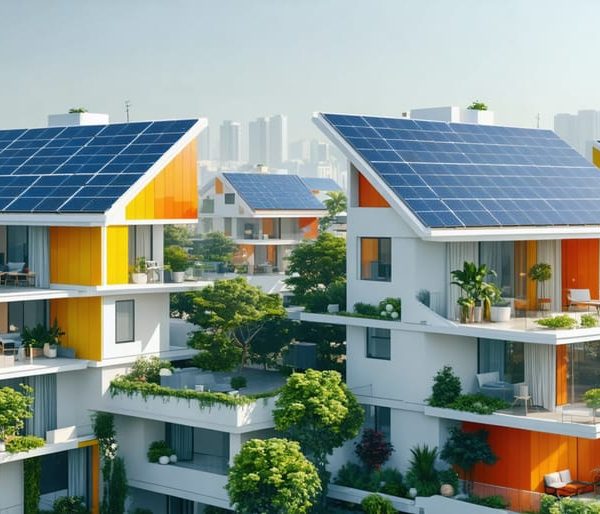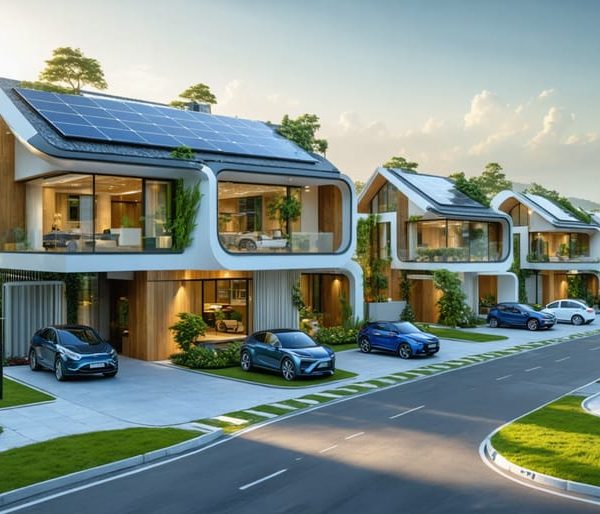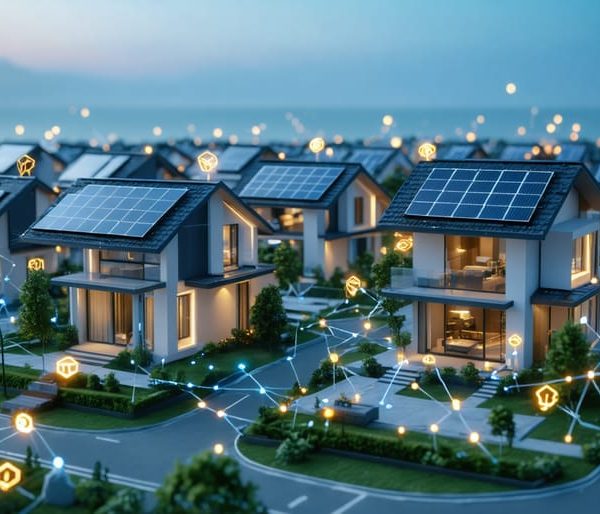Transform Your Home Into a Power Plant: Building-Integrated Solar Made Simple
Transform your building’s exterior into a powerful energy generator with building integrated photovoltaics (BIPV). Unlike traditional solar panels, these innovative solutions seamlessly blend into your roof tiles, windows, and façade materials, delivering clean energy while maintaining architectural beauty. Modern BIPV systems can reduce energy costs by up to 60% while increasing property value by an average of 4.1%, making them an attractive investment for forward-thinking property owners.
Imagine your entire building envelope working as a silent power plant – from solar glass windows that filter harmful UV rays while generating electricity, to sophisticated roof tiles that protect your home while capturing the sun’s energy. This revolutionary approach to sustainable architecture isn’t just about energy production; it’s about creating buildings that actively contribute to a cleaner future while looking absolutely stunning.
The technology has evolved dramatically in the past decade, with today’s systems offering unprecedented efficiency and design flexibility. Whether you’re planning a new construction project or upgrading an existing structure, BIPV solutions provide a sophisticated way to embrace renewable energy without compromising your building’s aesthetic appeal.
What Makes Building-Integrated Solar Different From Traditional Panels?

Aesthetics Meet Function
Gone are the days when solar panels meant compromising your building’s visual appeal. Modern building integrated solar solutions transform sustainable technology into architectural elements that enhance your property’s aesthetics. Solar roof tiles seamlessly blend with traditional roofing materials, while photovoltaic glass windows maintain the sleek appearance of conventional glazing while generating clean energy.
Designers now have access to a diverse palette of BIPV products in various colors, textures, and patterns. Solar facades can create stunning visual effects while powering your building, and solar skylights bring natural light while generating electricity. Even solar balustrades and canopies serve dual purposes as both functional building elements and power generators.
The key to successful BIPV implementation lies in early planning. By incorporating solar elements during the initial design phase, architects can ensure these components become natural extensions of the building’s structure rather than afterthoughts. This integration creates a cohesive look while maximizing energy generation potential, proving that sustainability and style can indeed go hand in hand.
Space-Saving Benefits
Building integrated solar offers a brilliant solution to one of the most common concerns about traditional solar panels – space utilization. Unlike conventional solar installations that require dedicated roof or ground space, BIPV components serve double duty by replacing traditional building materials while generating clean energy.
Think of solar roof tiles that not only protect your home from the elements but also power it, or window panels that provide both natural lighting and electricity generation. This dual functionality means you’re not sacrificing valuable real estate for solar power production. For commercial buildings, solar facades can replace standard cladding materials, turning otherwise passive surfaces into power-generating assets.
The space-saving advantages are particularly valuable in urban environments where every square foot counts. By integrating solar technology directly into building elements, property owners can maximize their available space while maintaining aesthetic appeal. This approach is especially beneficial for properties with limited roof space or those seeking to preserve ground area for other purposes like gardens, parking, or outdoor amenities.
Popular BIPV Applications for Your Home
Solar Roof Tiles
Solar roof tiles represent one of the most elegant solutions in building-integrated solar technology, seamlessly combining traditional roofing aesthetics with renewable energy generation. These innovative tiles look virtually identical to conventional roofing materials but contain photovoltaic cells that convert sunlight into electricity.
Unlike traditional solar panels mounted on top of existing roofs, these tiles completely replace your regular roofing materials. Each tile interlocks with its neighbors to create a watertight seal while maintaining the sophisticated appearance of a standard roof. They come in various styles and colors to match different architectural designs, from slate-like finishes to terracotta-inspired options.
Installation typically involves removing your existing roof and replacing it with these solar-enabled tiles. While this might seem daunting, many manufacturers have simplified the process by creating systems that professional roofers can install with minimal additional training. The tiles are engineered to be as durable as traditional roofing materials, often coming with warranties of 25 years or more.
The energy output varies depending on your roof’s size and orientation, but a well-designed system can generate enough electricity to significantly reduce or eliminate your monthly power bills. While the initial investment is higher than conventional roofing, the long-term energy savings and increased property value make it an attractive option for homeowners looking to embrace sustainable living without compromising on aesthetics.
Solar Windows and Skylights
Imagine transforming your ordinary windows and skylights into energy-generating powerhouses. Modern solar materials have made it possible to create transparent and semi-transparent solar panels that maintain natural lighting while producing clean energy.
These innovative windows use a special polymer layer sandwiched between glass panes that captures solar energy while allowing visible light to pass through. The technology comes in various transparency levels, typically ranging from 20% to 70%, letting you choose the perfect balance between natural light and energy production for your space.
Solar windows and skylights are particularly appealing for commercial buildings with large glass facades, but they’re also gaining popularity in residential applications. A standard solar window can generate between 8-10 watts per square foot, significantly contributing to your building’s energy needs while maintaining its aesthetic appeal.
Installation is surprisingly straightforward, as these units can often replace existing windows and skylights without major structural modifications. Many manufacturers offer plug-and-play solutions that connect directly to your building’s electrical system, making integration seamless.
The best part? These solar windows continue working even on cloudy days, capturing indirect light and converting it into usable energy. While the technology is still evolving, early adopters are already seeing the benefits of reduced energy bills and increased property values.

Solar Facades and Cladding
Solar facades and cladding transform ordinary walls into power-generating surfaces while maintaining architectural appeal. These innovative systems replace traditional building materials with photovoltaic panels that seamlessly integrate into the building’s exterior, creating a modern, sophisticated appearance.
Available in various colors, textures, and finishes, solar cladding systems can match existing architectural styles or create striking new designs. The panels can be installed vertically on building walls or at angles to maximize sun exposure. Some popular options include solar glass curtain walls, which replace traditional glass facades while generating power, and solar ceramic tiles that mimic conventional building materials.
Many property owners appreciate that solar facades serve multiple purposes: they act as weather barriers, provide thermal insulation, and generate clean energy. This multifunctional approach often results in significant cost savings over time, as these systems eliminate the need for separate cladding materials while reducing energy bills.
Installation typically involves mounting a supporting framework to the building’s structure, followed by attaching the solar panels. Modern systems often use rain-screen principles, creating a ventilated cavity between the building and panels that improves both energy generation efficiency and thermal performance.
For best results, solar facades are usually installed on south-facing walls in the Northern Hemisphere, though east and west-facing installations can also be effective depending on local conditions and energy needs.
Cost Considerations and ROI
When considering building integrated solar, the initial investment might seem substantial, but the long-term financial benefits make it an attractive proposition. The average cost for residential BIPV systems ranges from $15,000 to $50,000, depending on the type of integration, system size, and specific materials chosen. However, these systems can cut your energy bills significantly while increasing your property’s market value.
Several factors influence the return on investment (ROI) timeline. Most homeowners see complete payback within 7-12 years, with some achieving it even sooner in regions with high electricity rates or generous solar incentives. Federal tax credits currently offer a 30% reduction on installation costs, and many states provide additional rebates and incentives that can further reduce the initial investment.
The durability of BIPV systems also contributes to their cost-effectiveness. Modern solar tiles and panels typically come with 25-30 year warranties and can last even longer, providing decades of reliable energy production. Unlike traditional roofing materials that need periodic replacement, BIPV systems serve dual purposes – protecting your building while generating clean energy.
Maintenance costs are relatively low, usually limited to occasional cleaning and basic system monitoring. Many manufacturers now offer smart monitoring systems that help optimize performance and quickly identify any issues, ensuring maximum energy production and system longevity.
Property owners should also consider the increasing value of energy independence. As utility rates continue to rise, having your own power generation system becomes increasingly valuable. Additionally, many insurance companies now offer reduced premiums for buildings with BIPV systems, recognizing their durability and reduced risk profile.

Installation Process and Requirements
Installing building integrated solar requires careful planning and attention to detail, but the process can be broken down into manageable steps. Before beginning, property owners should conduct a thorough site assessment to evaluate their building’s solar potential and structural integrity.
The first step involves working with qualified professionals to develop a comprehensive installation plan. This includes architects who understand solar integration, structural engineers to assess load-bearing capabilities, and certified solar installers. These experts will help determine the most suitable BIPV products for your specific needs, whether it’s solar roof tiles, photovoltaic glass, or solar cladding systems.
Key requirements for installation include:
– A structurally sound building envelope
– Proper orientation and angle for optimal sun exposure
– Adequate roof or wall space for the desired power output
– Updated electrical systems to handle solar integration
– Compliance with local building codes and regulations
– Necessary permits and approvals
The installation process typically follows these stages:
1. Pre-installation preparation: Reinforcing the building structure if needed and preparing surfaces for solar integration.
2. Electrical system upgrades: Installing necessary wiring, inverters, and connection points.
3. BIPV component installation: Carefully placing and securing solar elements while ensuring proper weatherproofing.
4. System integration: Connecting all components and testing the electrical connections.
5. Final inspection and commissioning: Having the system reviewed by certified inspectors and utility representatives.
Weather considerations play a crucial role in the installation timeline. Most installations require several days to weeks of clear weather, depending on the project’s scope. Property owners should also plan for some disruption during the installation process, though many BIPV installations can be completed while the building remains occupied.
Maintenance requirements should be considered during planning. While BIPV systems generally require minimal maintenance, access points for cleaning and repairs should be incorporated into the design. Additionally, monitoring systems should be installed to track performance and identify any issues promptly.
For optimal results, working with experienced installers who specialize in building integrated solar is essential. They can ensure proper integration with existing building systems and maximize the system’s efficiency while maintaining the building’s aesthetic appeal and structural integrity.
Building integrated solar technology represents a remarkable advancement in sustainable architecture, offering a perfect blend of functionality and environmental responsibility. As we’ve explored throughout this article, BIPV systems do more than just generate clean energy – they transform ordinary building materials into power-generating assets while maintaining aesthetic appeal.
The benefits are compelling: reduced energy costs, increased property value, and a smaller carbon footprint. Homeowners can expect to see significant savings on their utility bills while contributing to a greener future. Commercial property managers find that BIPV solutions enhance their buildings’ market appeal while meeting increasingly strict environmental regulations.
What makes BIPV particularly attractive is its versatility. Whether you’re planning a new construction project or renovating an existing structure, there’s likely a BIPV solution that fits your needs. From solar tiles that blend seamlessly with traditional roofing to photovoltaic windows that maintain natural lighting while generating power, the options are diverse and growing.
As technology continues to advance and installation costs decrease, there’s never been a better time to consider BIPV for your property. By investing in building integrated solar today, you’re not just making a smart financial decision – you’re helping to shape a more sustainable future for generations to come.
Take the next step by consulting with a qualified BIPV installer to explore the possibilities for your property. The future of sustainable building is here, and it’s more accessible than ever before.











